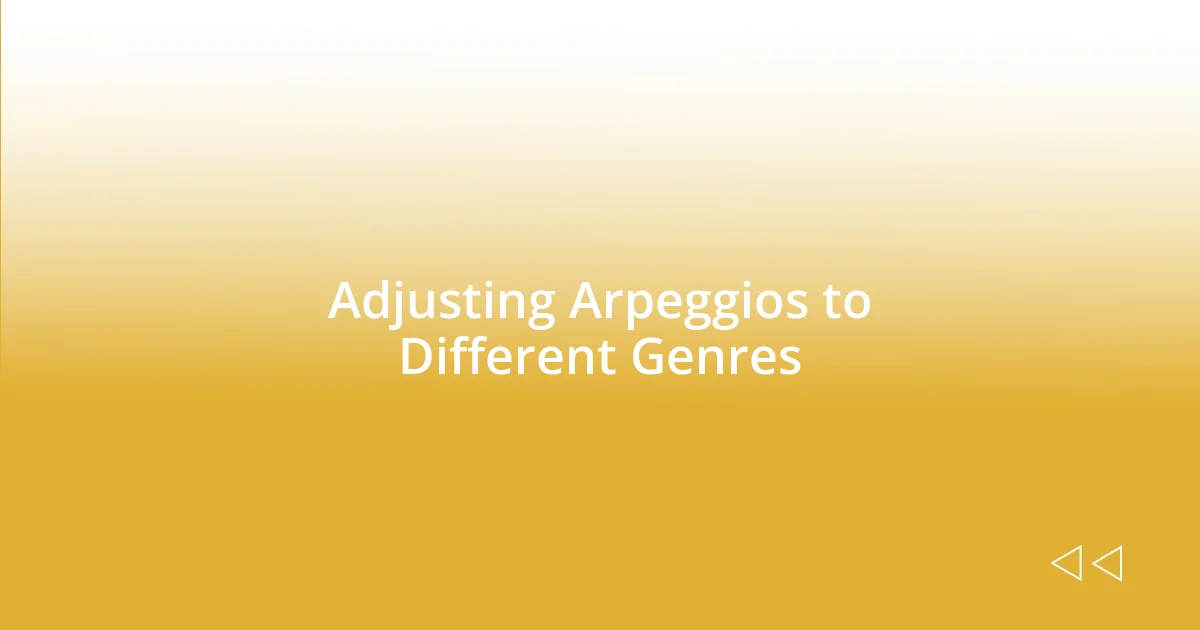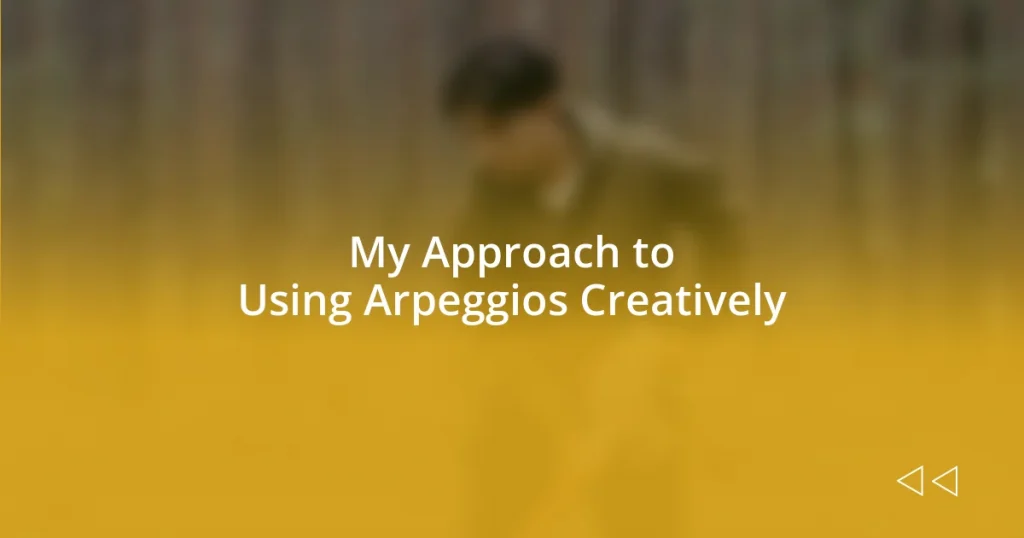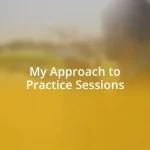Key takeaways:
- Arpeggios add depth, emotional impact, and create movement within music by transforming chord progressions and melodies.
- Techniques such as rhythmic variation, different voicings, and dynamics enhance creativity and expression when playing arpeggios.
- Adjusting arpeggios to fit various genres allows musicians to unlock new sounds and emotional layers, leading to innovative musical moments.

Understanding Arpeggios Basics
Arpeggios are essentially the notes of a chord played in succession rather than simultaneously. I remember the feeling of realization when I first learned that this technique could add depth and interest to my playing. Have you ever felt stuck in a routine with your chord progressions? Understanding arpeggios can be that lightbulb moment that transforms your music.
When I started experimenting with arpeggios, I found they opened up a whole new world of expression. In a way, they allowed me to tell a story with each note I played. Each arpeggio can evoke different emotions, and the way you choose to articulate each note can truly change the entire vibe of a piece.
It’s interesting to note that arpeggios can be found across various genres, from classical to jazz to rock. They’re not just exercises for technique; they’re creative tools waiting to be unlocked. When I realized I could use arpeggios to embellish a simple melody, it felt like discovering a secret weapon in my musical toolkit. Have you tapped into that potential yet?

Importance of Arpeggios in Music
Arpeggios play a crucial role in music by adding texture and flavor to compositions. I recall sitting down with my guitar, trying to capture a feeling of calm, and discovering that arpeggiating a simple chord progression instantly transformed it into something more evocative. It’s fascinating how a series of notes can create a melodic line that breathes life into the harmony, making it accessible and relatable to listeners.
Here’s why I find arpeggios indispensable in music:
- They enhance the emotional impact by allowing the musician to express nuances in each note.
- Arpeggios can create movement within a piece, generating a sense of progression and flow.
- Utilizing arpeggios can lead to unexpected discoveries in musical structure, inspiring new melodic ideas.
- They serve as a bridge between chords and melody, allowing for greater interplay in improvisation.

Techniques for Creative Arpeggio Playing
When I play around with arpeggios, I often find that varying the rhythm can lead to surprising musical moments. For instance, while practicing a simple arpeggio pattern, I once stumbled upon an offbeat rhythm that injected energy into a slower piece. It felt like giving this familiar pattern a breath of fresh air. Have you ever tried shifting the timing in your arpeggios? It can completely redefine how a piece feels.
Another technique I embrace is exploring different voicings. By altering the way I play an arpeggio, say by starting on different chord tones or using inversions, I create a new color in my music. I remember taking a standard C major arpeggio and starting on the G note instead; it turned a basic idea into something unexpected and intriguing. Have you noticed how different voicings can evoke varied emotions? They certainly can, and that’s what makes exploring them so rewarding.
To enhance my arpeggio playing further, I love integrating techniques like legato and staccato. The contrast between these two techniques adds dynamics to my arpeggiated lines. I often switch between playing smoothly and then suddenly becoming sharp and snappy, creating a playful dialogue within my music. Isn’t it exciting how a simple touch can bring so much life to each note you play?
| Technique | Effect |
|---|---|
| Rhythmic Variation | Creates new energy and excitement |
| Different Voicings | Introduces new colors and emotions |
| Legato & Staccato | Adds dynamics and contrast |

Incorporating Arpeggios in Improvisation
Incorporating arpeggios into improvisation feels like unlocking a treasure chest of creative possibilities. I often find myself blending arpeggios with a freeform approach when I’m jamming with friends. I vividly remember a night where, instead of following a strict chord progression, I used arpeggios freely, allowing the notes to guide me. That spontaneity led to some of the most magical moments of musical connection I’ve ever experienced. Have you ever felt the rush of exploring the unknown through your instrument?
One technique that has truly enhanced my improvisational skills is combining arpeggios with melodic phrasing. I once took a simple arpeggio and extended it with some embellishments. It started as I played a basic D major arpeggio but then added a few passing notes, transforming it into something uplifting and unexpected. It’s like painting with sound, and the colors you can create are boundless. What happens when you take an arpeggio and let it rise or fall dynamically? You’ll be amazed at how it can lead your audience on an emotional journey.
I also love integrating silences into my improvisation. There was a time I was lost in a session, and instead of rushing to fill each moment with notes, I paused between arpeggios, allowing the music to breathe. This created a sense of anticipation that was palpable. Have you ever tried using space as an instrument? It can be just as powerful as the notes you play, reinforcing the idea that improvisation is not just about filling the air with sound but also about inviting silence to dance alongside you.

Exploring Unique Arpeggio Patterns
Exploring unique arpeggio patterns has become a thrilling adventure for me. The first time I tried a descending arpeggio pattern, I was struck by how it completely changed the mood of the piece I was working on. It added a haunting quality that lingered in the air, almost like an echo of my thoughts. Have you ever noticed how the direction you play an arpeggio can evoke different emotions? It’s fascinating how something so simple can bring such depth to your music.
I love experimenting with irregular patterns, such as skipping notes or adding extra beats to a traditional arpeggio sequence. One evening, while I was practicing, I decided to take a basic A minor arpeggio and mix in some unexpected jumps. The resulting sound was refreshingly different, lifting me out of my routine and sparking my creativity. How often do you venture away from the norm in your playing? The beauty lies in the surprises you uncover.
Incorporating rhythmic shifts within arpeggio shapes can also breathe new life into a familiar melody. I remember once shifting a straightforward arpeggio into a syncopated rhythm, which turned a well-known passage into something vibrant and full of energy. It’s rewarding to witness your audience’s reactions as they process this fresh take on the music. Have you tried mixing up the rhythm of your arpeggios? Embracing that kind of exploration can lead to some truly memorable moments in your performances!

Adjusting Arpeggios to Different Genres
Adjusting arpeggios to fit different genres is like tailoring a suit for an occasion; it requires an understanding of the unique characteristics of each style. For instance, when I delve into jazz, I often find myself adding seventh and ninth notes to my arpeggios. This not only enriches the harmony but also adds a smoother, more complex emotional layer to my playing. Have you ever felt the difference in your sound when you adapt an arpeggio for jazz? It’s a subtle shift that can transform an entire piece.
In rock music, I’ve noticed that using power chords in the form of arpeggios can create a powerful effect. I remember jamming with a friend when I opted to break down a standard power chord progression into arpeggiated patterns. Suddenly, that gritty, driving energy was matched with an intricate melodic flair, creating an exhilarating contrast. Have you ever thought about how these adjustments can energize a performance? It’s amazing how the right approach can amplify the emotional punch of your music.
Then there’s the influence of classical music, where the elegance of arpeggios can be truly mesmerizing. I once worked on a piece that incorporated arpeggios not just as a backdrop but as the main theme, weaving them into the melody seamlessly. The immediacy of those cascading notes made the composition feel alive. How do you adapt arpeggios for a classical context? It’s gratifying to see how different genres can inspire innovative approaches; each genre is a new canvas for your arpeggio creativity.

Examples of Creative Arpeggio Use
Using arpeggios in unexpected contexts can lead to innovative and memorable musical moments. For example, while experimenting with a folk tune, I decided to create a plucking pattern that alternated between major and minor arpeggios. The contrast added a touch of playfulness and nostalgia, making my audience lean in closer, as if they were sharing a secret with me. Have you ever played with the colors of your arpeggios in this way? It’s a delightful journey that can breathe new life into what might seem like a simple melody.
Another intriguing approach I took was integrating arpeggios into a spoken word performance. By underlining certain phrases with delicate arpeggio runs, I found that the words gained an added emotional weight. The ebb and flow of my phrases danced alongside the music, creating a captivating synergy. Have you ever thought about how your playing could enhance storytelling in your performances? That interplay can elevate the experience, drawing listeners into a more immersive world.
Incorporating dynamics can also yield striking results with arpeggios. One evening, I was at an open mic and decided to play a quiet arpeggio section that gradually built up to a powerful climax. The gradual shifts from soft to loud drew the audience in, creating palpable tension. When I reached the peak, the room was filled with energy, and I could feel the collective breath of the audience. Have you ever tested the power of dynamics in your arpeggios? It’s a simple technique that can evoke a profound emotional response, transforming any piece into an unforgettable experience.















